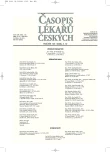Milestones of Cardivascular Pharmacotherapy: Salicylates and Aspirin
Authors:
P. Jerie
Published in:
Čas. Lék. čes. 2006; 145: 901-904
Category:
Review Article
Overview
The analgesic and antipyretic effect of the bark of willow has been known in Egypt and Greece for canturies. The modern era of salicylates starts with a letter sent 1758 by Reverend Edward Stone to The Royal Society in London. He described „an account of the success of the bark of willow in the cure of agues“. His report. erroneously attributed to Edmond Stone. was published five years later. The active ingredient of willow bark. „salicine“. was first isolated 1828 by Joseph Buchner, then by Henri Leroux, and also prepared from the oil of wintergreen (Gaultheria) and meadowsweet (Spirea ulmaria) by J. W. Lowig 1833. and called „Spirsäure“, which was already pure acetylsalicylic acid. It was also synthetised 1853 by Ch. Gerhardt and finally 1897 in Bayer’s laboratoires by Felix Hoffman, who also demonstrated its antiihflamatory efficacy. After two years of clinical trials with low doses, Bayer’s management decided to start the productions and launched Aspirin as an analgetic worldwide in summer 1899. The first ASPIRIN ERA bagun. A completely new epoch started when J. N. Vane and Priscilla Piner demonstrated 1971 that the main mechanism of action of aspirin-like drugs is the inhibition of prostaglandin synthesis. In later studies the potency to inhibit platelet aggregation with small doses of aspirin (30–125 mg) was demonstrated. The Physicians’Health Study 1988 confirmed this effect: aspirin significantly reduced the risk of both. fatal and non–fatal myocardial infarction. and is now used in primary and secondary prevention of atherosclerosis. However the idea was not new: The use of salicylates and aspirin was throughly discussed more than 50 years ago: Paul C. Gibson published 1949 a welldocumented case report on efficacy of aspirin in patients with angina, and Kl. Weber and P. Klein in Prague used Gibson’s mixture successfully for patients with acute myocardial infarction (1951). Recently, the efficacy and security, the interactions and side–effects of low–dose aspirin have been studied and discussed. In chronic treatment, any combination of two specific platelet antiaggregants should be avoided.
Key words:
salicylates, aspirin, acute myocardial infarction, antiaggregants.
Labels
Addictology Allergology and clinical immunology Angiology Audiology Clinical biochemistry Dermatology & STDs Paediatric gastroenterology Paediatric surgery Paediatric cardiology Paediatric neurology Paediatric ENT Paediatric psychiatry Paediatric rheumatology Diabetology Pharmacy Vascular surgery Pain management Dental HygienistArticle was published in
Journal of Czech Physicians

Most read in this issue
- Hair Whorl-A Genetically Bound Phenomenon in Testing of Right-handedness and Hemispheric Dominance
- Dermatophytoses Transmitted from Animals
- Tako-tsubo Cardiomyopathy – Our Experience and Review of Current Knowledge
- Geriatric View on the Health and Disease in Old Age – Changes in the Paradigm?
